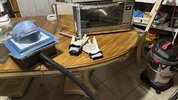After weeks and weeks of trying to lay my hands on a vacuforming machine, I said screw it and decided to build my own. I have no clue what I'm doing and I'm working with chemicals and electricity, so lets try not to mess it up too badly!
My frame is going to be made of aluminum angle. Considering that the sheets of plastic I'm working with are 12" square, I found that a 4" length, cut on ONE side every 10.5", created a large enough square frame to hold each sheet. Don't forget to make 2 of these frames!

Now, welding aluminum is a pain in the neck and anyway welders are expensive, so we're gonna use the old shade tree mechanics friend, JB Weld (its not like we don't have a bunch of bondo laying around and enough spraypaint to kill a Bond girl...)
I cannot stress this enough, we are working with a binary chemical agent that welds metal, proper PPE is a requirement. Gloves, respirator, eye protection.




Now, we've got about 6 hours to pass until that JB Weld sets... Time to become a carpenter...

Cut two chunks of 2x4 to 10 1/2", and two more to 7 3/8", because 2x4s aren't actually 2x4, then glue and clamp. We're going to screw this all together later, but the glue needs to cure. While you're doing that, cut a 10 1/4" square of pegboard, and a 12x10 chunk of some MDF.

Remember that your actual working space is going to be smaller than this overall surface, but I'm making this based on the size of the sheets of material I bought on Amazon, so go with it. Glue the MDF to your box frame and put a big heavy weight on it.

Then go to bed because you're an adult who exists under capitalism and its bed time.
My frame is going to be made of aluminum angle. Considering that the sheets of plastic I'm working with are 12" square, I found that a 4" length, cut on ONE side every 10.5", created a large enough square frame to hold each sheet. Don't forget to make 2 of these frames!
Now, welding aluminum is a pain in the neck and anyway welders are expensive, so we're gonna use the old shade tree mechanics friend, JB Weld (its not like we don't have a bunch of bondo laying around and enough spraypaint to kill a Bond girl...)
I cannot stress this enough, we are working with a binary chemical agent that welds metal, proper PPE is a requirement. Gloves, respirator, eye protection.
Now, we've got about 6 hours to pass until that JB Weld sets... Time to become a carpenter...
Cut two chunks of 2x4 to 10 1/2", and two more to 7 3/8", because 2x4s aren't actually 2x4, then glue and clamp. We're going to screw this all together later, but the glue needs to cure. While you're doing that, cut a 10 1/4" square of pegboard, and a 12x10 chunk of some MDF.
Remember that your actual working space is going to be smaller than this overall surface, but I'm making this based on the size of the sheets of material I bought on Amazon, so go with it. Glue the MDF to your box frame and put a big heavy weight on it.
Then go to bed because you're an adult who exists under capitalism and its bed time.


